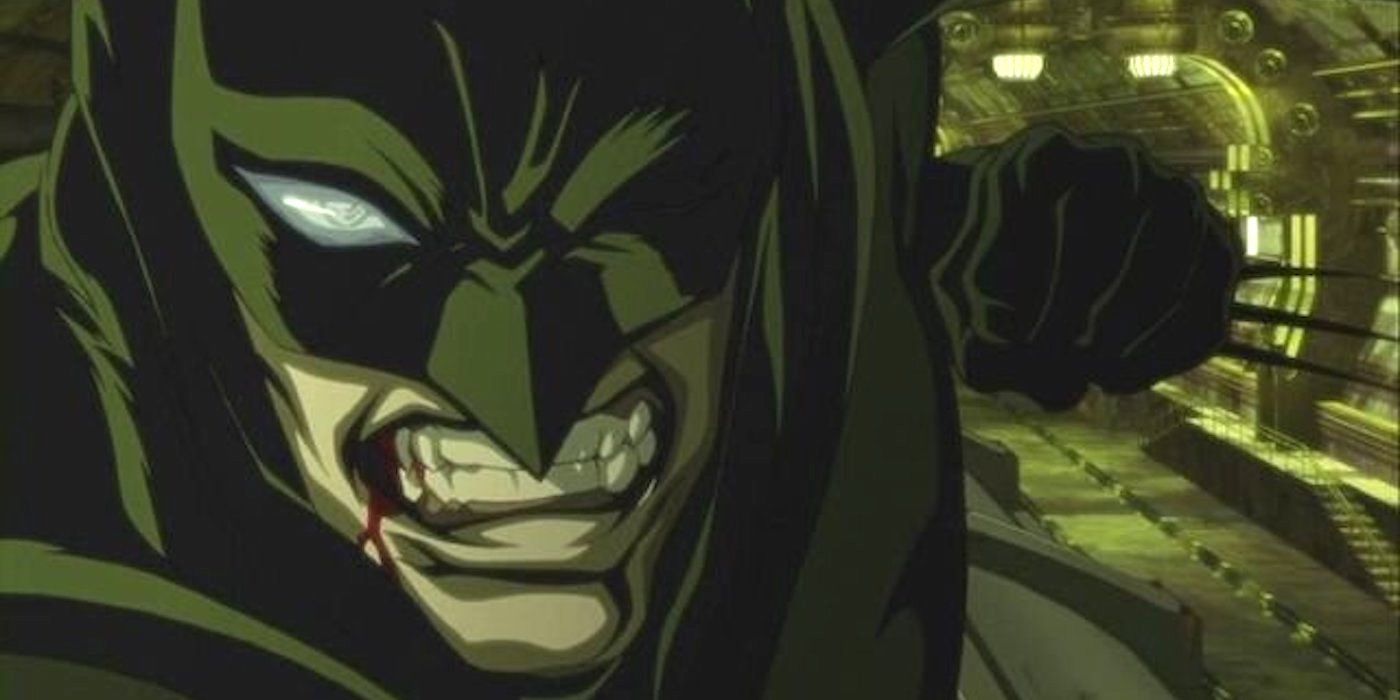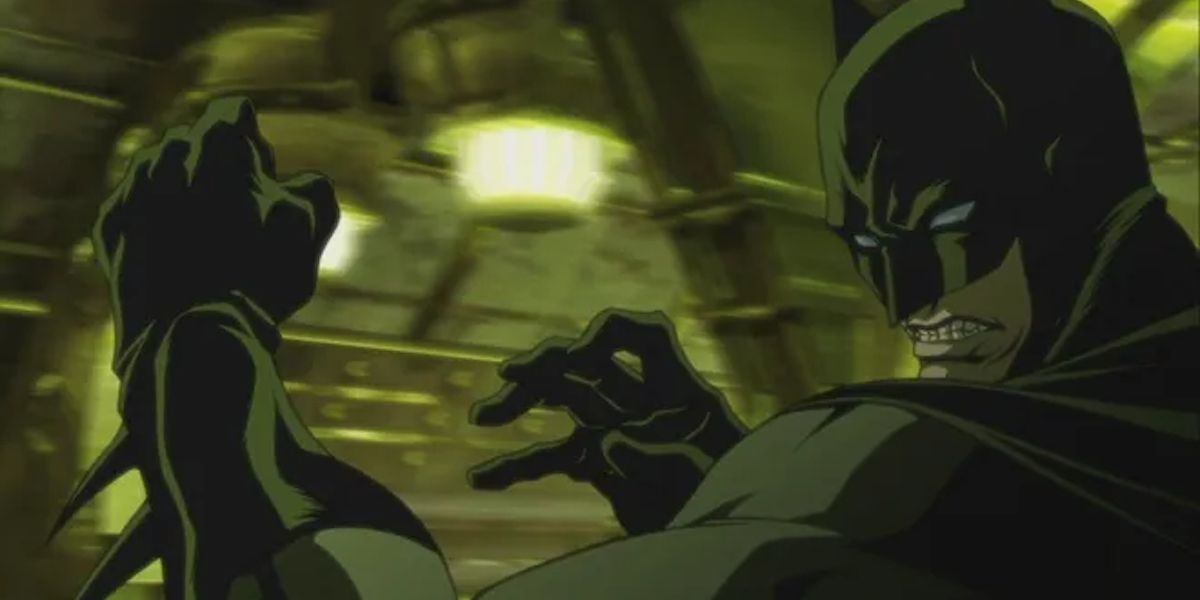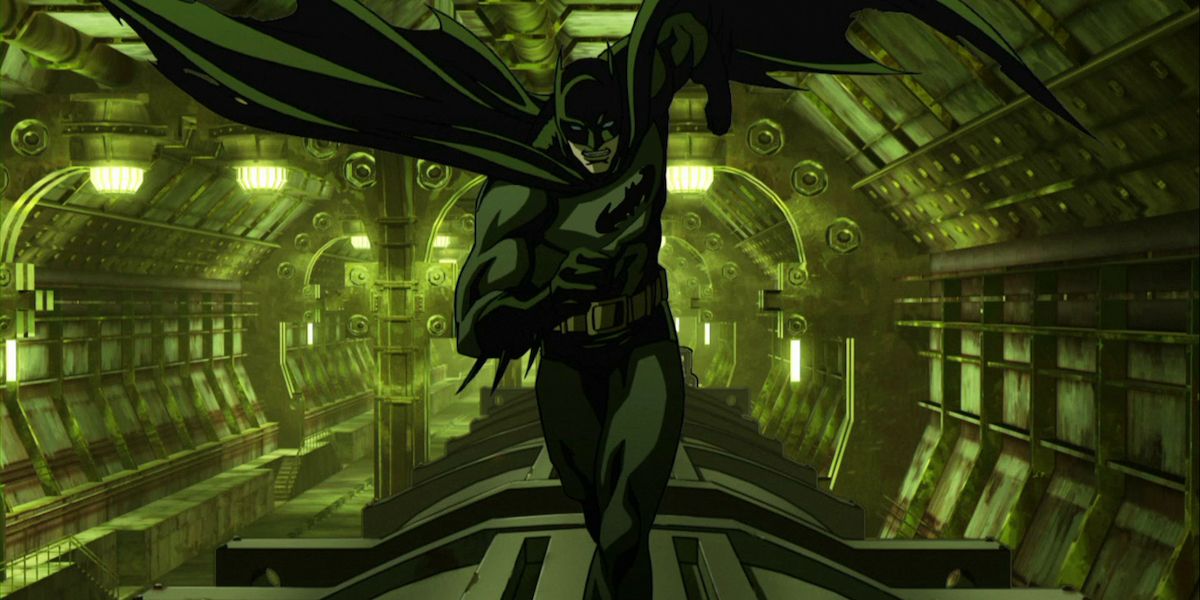2008 was a good time to be a Batman fan. July saw the release of The Dark Knight, popularly considered one of the best superhero films ever made. Its gritty and realistic tone laid the groundwork for the next decade of Hollywood, and cemented Christopher Nolan as one of his generation’s defining filmmakers. Fourteen years on, its influence shows no sign of disappearing, but just ten days before its release in the United States, another film featuring the titular Dark Knight quietly released on DVD. The film was Batman: Gotham Knight, an animated anthology consisting of six different stories told by six different directors, all of whom are prominent names in the world of Japanese animation. It was an intriguing prospect, and the idea of a simpler take on such a popular character that departed from the grandness that was steadily becoming the norm for comic book films was a refreshing one. Not surprisingly its bigger brother hogged all the limelight, leaving Gotham Knight as a curious footnote for those interested in the animated adventures of their favorite Caped Crusader, but the film deserves better. Its anthology format affords the film a unique perspective on an overdone genre, and the short length of its stories allows for some of the most creative Batman tales in years. More superheroes should embrace the anthology treatment, and Gotham Knight is the perfect example why.
One of the greatest strengths of an anthology film is the freedom it affords a writer. Rather than having to stretch out an idea to a minimum of ninety minutes that fits neatly into a three-act structure, writers are free to concentrate on the core tenets of their story without having to worry about filler. Much like a short story, writers often eschew the first act entirely in favor of getting right to the heart of the narrative, a structure that is perfectly suited for quick consumption. It’s a format that harkens back to the comic book origins of these characters where writers had to operate under a strict page limit, and the result was a series of wildly inventive stories that served as fun explorations of their protagonists and their respective universes. It’s a concept akin to the monster-of-the-week format of shows like The X-Files and Star Trek: The Next Generation, and in an age where long-form storytelling is increasingly becoming the norm across all mediums, they serve as two of the best reminders that shorter, more standalone narratives are an equally rewarding form of storytelling.
It’s in this area where Gotham Knight excels. Each of its stories builds out from a strong central idea that, while they would have crumbled under their own fragile weight in a feature-length production, have more than enough strength to sustain a ten to fifteen-minute short. For example, the opening segment called Have I Got a Story for You depicts four teenagers who have all had an encounter with Batman that day, each of whom perceives him differently. One of them sees him as a living shadow who can disappear and reappear at will, while another sees his apparent invincibility as proof that he’s a robot. Its themes of perspective and false memory reveals an obvious debt to Rashomon, but also serves as a compelling exploration of how the citizens of Gotham perceive the masked vigilante that has taken upon itself to become their protectors. The sequence clocks in at just over twelve minutes, the perfect length for it to establish its concept, explore it in sufficient depth, and then provide a satisfying conclusion, all the while telling a story unique to Batman’s silver screen iterations. It’s nothing revolutionary, but it doesn’t have to be, and its twist on the usual formula makes it an essential watch for any Batman fan.
This concept applies to all of the remaining shorts. Crossfire, for example, embraces the gritter side of the franchise by placing the focus on two members of James Gordon’s Major Crimes Unit as they unwittingly get drawn into a conflict between two rival gangs. Working Through Pain jumps into Batman’s past as he reflects on when he was volunteering with a relief effort, leading to an encounter with a mysterious woman who teaches him a valuable lesson about managing pain. Deadshot, meanwhile, is a more traditional Batman story, pitting the World’s Greatest Detective against the World’s Deadliest Assassin in an action-packed sequence that serves as the film’s grand finale. Adding to their distinctiveness are the unique visual styles of each short, courtesy of four of Japan’s largest animation studios. It gives each short a clear identity that perfectly complements the mood of each story, but without ever being so radically different from its companion pieces as to become distracting. None of these stories would sustain a longer running time without a large number of additions being required (a change that would only negate the elegance and simplicity of the original idea), but in their current form they make for fascinating little exertions into the crime drenched world of Gotham City, providing a snapshot view of its populace and the various exploits they get into that a broader approach would not have allowed for.
But if the anthology format lends itself to superheroes so well, why are there so few films that take advantage of it? The answer comes down to quality. Anthologies are notoriously hit and miss, and with a new creative team taking over each story, it’s almost impossible to maintain a level of quality throughout. Take Black Mirror, for example. The show may have episodes like “San Junipero” that have become staples of the greatest television episodes of the 2010s lists, but it also has plenty of episodes destined to be forgotten as soon as the end credits start rolling. Black Mirror does better than most in this regard, as it at least has the consistent throughline of Charlie Brooker writing or co-writing most episodes, with most lacking an equivalent piece of connective tissue. It’s an issue anthology films have had to deal with from the days of Heavy Metal all the way to The Ballad of Buster Scruggs, and the difficulties with avoiding this issue while still ensuring each story is given the creative freedom it deserves means it’s often easier to just focus on telling one story well rather than multiple inconsistently.
This is another issue that Gotham Knight avoids. Rather than having each story being totally disconnected from everything around it, the film instead frames each story as taking place within the same short timeframe, with plotlines from one continuing in another. These connections are relatively minor, such as the Man in Black who was causing havoc in Have I Got a Story for You being the same Man in Black the police are transporting to Arkham Asylum in Crossfire, but they help give the film a sense of cohesion while still maintaining the strengths of the format. It gives a reason why these particular Batman shorts have been compiled together rather than any other arrangement of shorts that DC has produced over the decades, and gives Gotham Knight that rare honor of working in both an episodic and feature-length structure.
Despite its rarity, other superhero properties have attempted the anthology format, but with a more mixed result. The animated film Green Lantern: Emerald Knights tried to do the same for Hal Jordon, and the recent What If…? series on Disney+ has reinterpreted various moments from throughout the MCU’s history in a series of self-contained episodes. Unfortunately, neither matches the success of Gotham Knight. The decision for Emerald Knights to use the same group of directors for all six stories (all using a singular art style) causes them to blur together in a way that entirely misses the point of an anthology film, an issue the distinctiveness of its Batman counterpart masterfully avoided, while What If…? only half embraces the anthology format by ultimately tying many of its stories together in the season one finale. It also suffers from connecting itself so closely to the larger MCU, meaning it never feels like its own complete work rather than a side quest to the main adventure.
It’s here where some would argue that Gotham Knight suffers from this problem too, but this is an egregious allegation. The film does claim to be a part of the Christopher Nolan trilogy (taking place between Batman Begins and its sequel), but the connections are tenuous at best. The most obvious one comes in the fourth story In Darkness Dwells, which sees Batman investigating a riot at a cathedral that has all the signs of the Scarecrow’s fear toxin behind it (a character still at large following the events of Batman Begins). The segment was written by David S. Goyer who also worked as a writer on all three Nolan films, but as is to be expected in a straight-to-DVD film, nothing that occurs in this sequence has any repercussions in the subsequent film. Nolan himself had no involvement in the project, as did none of his cast, making it easy to watch Gotham Knight and never even realize it has a link to his films. Compare this to What If…?, which happy drags up most cast members who have made even a passing appearance in the MCU while also tying all of its episodes around a pivotal moment from one of its films. It makes for an enjoyable watch, no doubt about it, but it never feels like it’s exploring the anthology format as best as it could.
Gotham Knight is unlikely to join the ranks of The Caped Crusader’s greatest films, but it doesn’t have to, and nor does it feel like its creators are aiming for that anyway. Instead Gotham Knight acts as a celebration of its titular character, exploring each corner of his world in a film that’s constantly reinventing itself. It’s a brilliant reminder that not everything involving our favorite comic book heroes has to be epic in scope, while also allowing writers to provide fresh twists on an established formula that can be all killer, no filler. Of the seemingly endless number of animated films to feature Batman, Gotham Knight remains one of the most exciting, and more superhero films should be willing to follow its formula.
























































![Key Metrics for Social Media Marketing [Infographic] Key Metrics for Social Media Marketing [Infographic]](https://www.socialmediatoday.com/imgproxy/nP1lliSbrTbUmhFV6RdAz9qJZFvsstq3IG6orLUMMls/g:ce/rs:fit:770:435/bG9jYWw6Ly8vZGl2ZWltYWdlL3NvY2lhbF9tZWRpYV9yb2lfaW5vZ3JhcGhpYzIucG5n.webp)




















